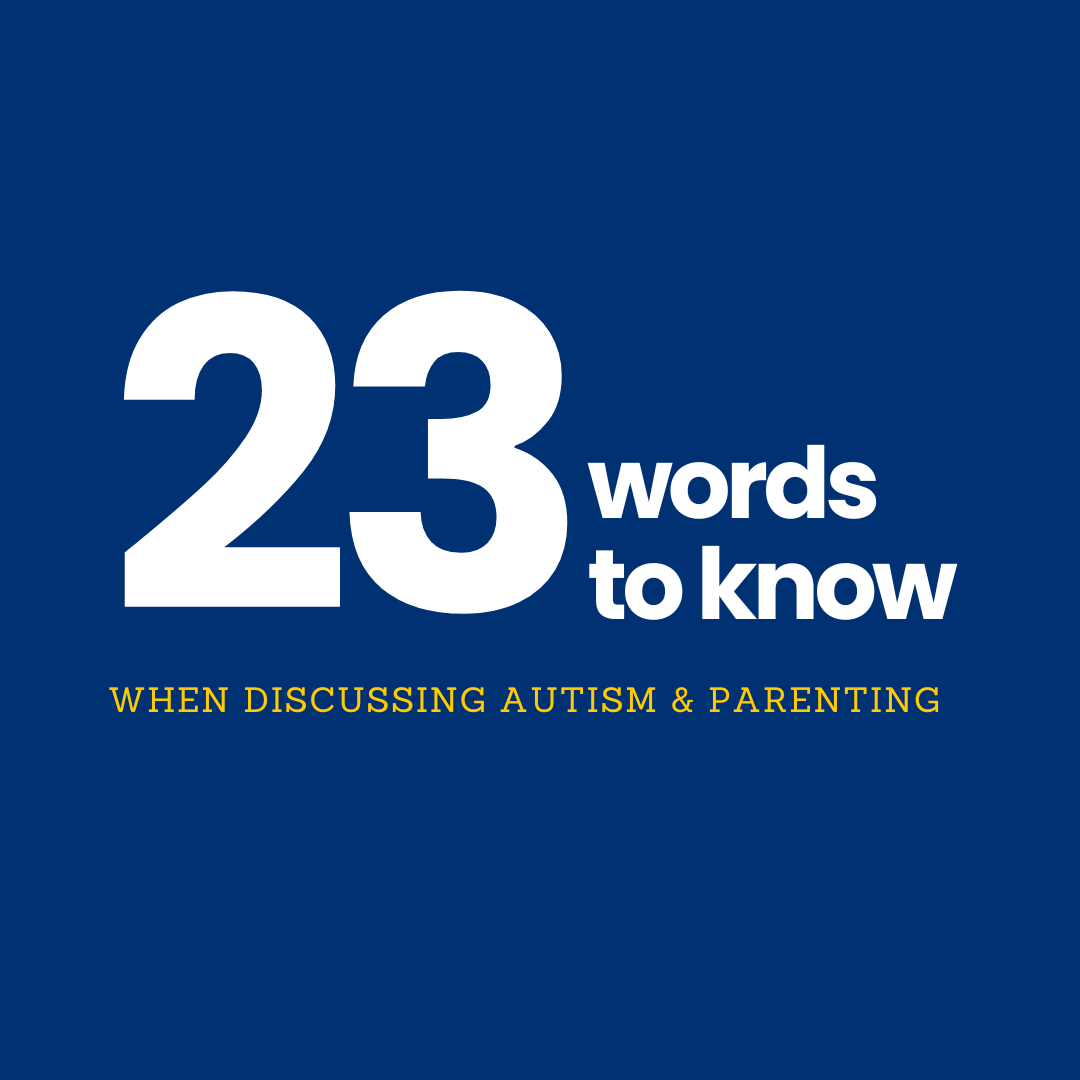
23 Words to Know When Discussing Autism & Parenting
Share
When we first started this journey over 2 years ago, we were introduced to a library of terms & phrases that were honestly confusing AF & it was a lot to digest! Even now, the terminology is changing so I wanted to create a little cheat sheet of common words & phrases we’ve learned in the process. From the very commonly heard Autism Spectrum Disorder definition to a 504 Plan, I did my best to cover it!
Please let me know if there are any other terms you’d like to see me add & I can update my list!
Here’s our list of the 23 must-know words when discussing Autism:
504 PLAN
A general plan that ensures a student with any disability will receive accommodations that will help them to achieve academic success. A 504 plan can be utilized on an as-needed basis & does not necessarily mean a child qualifies for special education services. Everything included in a 504 can be included in an IEP.
APPLIED BEHAVIORAL ANALYSIS [ABA] THERAPY
Behavior Therapy used for life skills development, social adaptability & learning basic skills. It is also used to assist in decreasing negative behaviors that could be harmful to the individual & affect learning.
AUGMENTATIVE & ALTERNATIVE COMMUNICATION [AAC]
Forms of communication [other than verbal speech] that are used to express thoughts, needs, & wants. People with severe speech or language problems rely on AAC to supplement existing speech or replace speech that is not functional.
AUTISM SPECTRUM DISORDER
A complex developmental condition that involves persistent challenges in social interaction, language communication, & repetitive behaviors. The effects of ASD are different in each person.
DEVELOPMENTAL DELAY
A slower rate of development in comparison to the majority of others of the same age.
ECHOLALIA
This is the repeating of sounds, words, or phrases. It’s noticeable when individuals basically parrot back what they have heard from another. If they are asked a question, they may repeat the question over instead of answer it. They may even repeat section of the original question/statement then respond with the same diction. A mirrored form of communication. Echolalia is often confused with Scripting.
GESTURES
Sign language falls in this category. Before Jackson started using words or even started pointing, he would gesture, or lead us, to items he wanted. He knew exactly what he wanted but didn’t have the words to communicate so he did the next best thing, which was gesturing.
INCLUSION
Basically the word of the last couple years LOL. The practice of inclusion is based on educating all, including those with physical, mental, & developmental disabilities. However, it has grown to providing a welcoming space to any & everyone, regardless of abilities.
INDIVIDUALIZED EDUCATION PLAN [I.E.P.]
A specialized plan developed that essentially serves as a blueprint or roadmap for a child with special education services. It includes comprehensive information about a child’s diagnoses, needs, recommended services, and accommodations, and pretty much anything else pertaining to the child’s unique identifying factors. It’s formal and legally binding, and is the result of a comprehensive evaluation.
MELTDOWN
Very often mistaken as temper tantrums. These are typically not anger-infused, but the body’s way of reacting to a confusing or over-stimulating situation. Meltdowns can be both loud or they can be very quiet.
NEUROTYPICAL [NT]
In simple terms, this term describes those that are not on the Autism Spectrum. Not to be confused with Neurodiverse or Neurodivergent [differing in mental or neurological function from what is considered typical or normal / having a brain that's wired differently].
NON-VERBAL
Being non-verbal means the person does not learn how to speak. It’s estimated that 25% - 50% of children diagnosed with Autism never develop spoken language beyond a few words. I believe asking if someone is verbal or non-verbal at the beginning of an interaction is so important because it can help make the conversation easier to understand. There are also numerous ways to communicate that aren’t verbal. Some examples are eye contact/gaze, facial expressions, body posture & gestures.
PECS [Picture Exchange Communication System]
A form of AAC communication for non-verbal children. PECS is typically used with a velcro system where the child would remove the item from the velcro board & bring it whoever. We chose to not use a PECS system because we have smaller kids & I knew we would loose so many pieces.
PROPRIOCEPTIVE INPUT
The entire reason we have 2 trampolines within our household. Proprioceptive input is being able to “feel” the space around you. Actions like clapping, flapping & jumping provide that input. At the same time, actions like brushing of skin & tight, brief squeezes also provide that feedback.
REINFORCEMENT
A principle of ABA Therapy. There are 2 types of reinforcement: positive & negative. Positive reinforcement is when a positive consequence is presented immediately following the positive behavior to increase the chances of that behavior happening again. Negative reinforcement is removing the negative stimulus to decrease the chances of that behavior happening again.
REGRESSION
The loss of skills that have previously been learned.
SCRIPTING
The repetition of words, phrases, intonation, or sounds of the speech of others. Often taken from movies or videos. Jackson scripted A LOT, but we knew it wasn’t Echolalia because he wasn’t trying to communicate with us. He was just repeating things because he enjoyed the way they felt.
SELF STIMULATORY BEHAVIOR [Stimming]
Repetitive behavior [such as the spinning of objects, rocking, flapping], vocal echoes or other repetitive actions to alleviate the stressors of overstimulation. Can also include oral fixations. This varies from person to person.
SENSORY PROCESSING DISORDER [SPD]
A neurological condition that exists when sensory signals aren’t processed in order to correctly meet the needs of the environment. For example, Jackson has food aversions with colors or textures & seeks proprioceptive feedback.
SPLINTER SKILL
I am so excited for whatever Jackson’s skills is/are! These will be the skills that are stronger than his others. A person with autism might be able to do one or more things really well but have far less ability in other areas.
TRANSITION
A change from one environment or activity to another. Verbal warnings or countdowns are very helpful in these cases.
VESTIBULAR SYSTEM
All about inner ear balance. This system give you awareness of balance & spatial orientation. Basically anything has your feet off the ground & encourages movement involves this system. Jackson seeks this sensory input but only if he can control it.
VISUAL SCHEDULE
These tell someone what to expect next & in what order. Many benefit from this information so it makes it easier for them to transition from one activity to another. Similar things like a countdown clock are very helpful with Jackson.
I truly hope that with these quick definitions, you’ll better be able to help your child on their new journey! & not only that, better interact with other people on the Spectrum. Please let me know if there are any other words you’d like seen or need assistance with!

